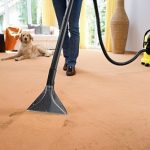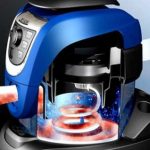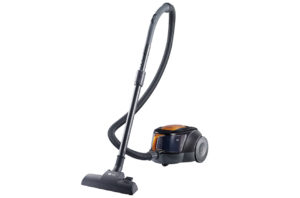 The standard design of the household gadget for cleaning the premises initially implied the presence of a special container for collecting dust. Over time, manufacturers have developed a unique technology for bagless vacuum cleaners to collect collected dirt. Such an innovation aroused increased interest on the part of customers, which encouraged the corporation to firmly “root” advanced development in the consumer market of electronic equipment. So what are its features? Is it really worth choosing the first option between a bagless vacuum cleaner and a model with a dust collecting flask? Having studied the article below, you will be able to get answers to these and other questions related to the types of the considered line of household devices, as well as their main advantages and disadvantages.
The standard design of the household gadget for cleaning the premises initially implied the presence of a special container for collecting dust. Over time, manufacturers have developed a unique technology for bagless vacuum cleaners to collect collected dirt. Such an innovation aroused increased interest on the part of customers, which encouraged the corporation to firmly “root” advanced development in the consumer market of electronic equipment. So what are its features? Is it really worth choosing the first option between a bagless vacuum cleaner and a model with a dust collecting flask? Having studied the article below, you will be able to get answers to these and other questions related to the types of the considered line of household devices, as well as their main advantages and disadvantages.
What it is
Based on the name of the gadget, it is logical to assume that, according to the design, the household appliances in question are a vacuum cleaner with a dust container, traditionally made of plastic or filled with water, instead of the usual fabric bag. It is not surprising that many buyers are willing to overpay for a bagless gadget that can deliver a greater degree of comfort in use when comparing it with a “fabric” analog.
In order to correctly choose the most suitable device for your goals, it is important to keep in mind its classification by type of dust collector. Among vacuum cleaners with a bagless dust collection system, there are:
- cyclone (a plastic tank, in most cases used in conjunction with a HEPA filter, which provides the maximum possible purification of the blown air, which makes it possible to use a vacuum cleaner of this kind by people prone to allergic reactions);
- aquafilter (the filtering tank is filled with water, which allows you to "hold" the smallest particles of contaminants, potentially containing dangerous microorganisms or allergens inside the household cleaning device).
The main feature of the “automated assistant” without a dust bag can be considered the use of HEPA filters in the designs of their best models, and the “sponge” cleaning cartridge in cheaper versions.
In addition, when cleaning the premises using a cyclone vacuum cleaner or a gadget with an aquafilter, you can be sure of a constant suction power throughout the entire process. This characteristic cannot be attributed to the traditional type of household appliances, in view of the inherent decrease in the productivity of the cleaning process as the bag dust bag is filled. This flaw conventional vacuum cleaners this is perhaps the main reason why customers are increasingly choosing the container type of “automated cleaner”.
- In addition to the consistently high quality of cleaning the flooring, among the advantages of bagless devices, it is worth noting their compactness and low weight. Most of the models can be described as “small and powerful”, which undoubtedly cannot but attract users, in view of the most frequent cleaning by representatives of the “weaker” floor.
- The compact lightweight gadget of this type, despite its size, is a leader among household devices in its ability to rid the room of accumulated dust and dirt (especially in the case of an aquafilter).
- In addition to the quality of the cleaning, even the most inexpensive representatives of "bagless assistants" they do not require their user a laborious process of "shaking out" the garbage from the dust collector. To maintain the functional elements of the device in its original form, it is enough to thoroughly rinse the dust collector with running water after each cleaning cycle.
- Powerful “household babies” do not need regular replacement of components, in particular, a fabric bag for collecting dust. This advantage allows not only to save finances on the acquisition of expensive consumables, but also the time spent searching for replaceable dust collectors, especially when using a gadget of a little-known brand.
Which is better - with or without a bag?
Of course, bagless vacuum cleaners are not ideal and, along with their traditional counterparts, have a number of disadvantages. A review of the most popular of them allowed to highlight:
- decrease in "working capacity" with frequent adoption of a horizontal device;
- electrostaticity of the material used for the manufacture of the housing of the household appliance of the type in question;
- relatively quick "wear" of the functional components of the device with frequent contact with water (about cyclone vacuum cleaners).
The negative aspects described above of using bagless household appliances for cleaning the floor do have a place to be, but how critical are they in comparison with the disadvantages of devices with a fabric dust collector? Which is better in terms of technical components - bag vacuum cleaner or without him? To form an objective assessment of this issue, we suggest that you refer to the table below.
| Characteristic | Bag vacuum cleaners | Bagless Vacuum Cleaners |
| Original power | high but decreases as the dust bag fills | average, but will be stable throughout the entire cleaning process |
| Frequency of purchase of expensive replacement parts | Often | seldom |
| Cleaning Efficiency | depends on the model, but most often average or below average | always high, due to the use of HEPA filters in most models |
| Easy gadget care | low when using a reusable dust bag | high |
| Noise level created in the work | medium (most models) | below average (current models) |
Thus, if you want to purchase as quiet as possible, a compact, easy-to-use and easy-to-use vacuum cleaner, which is not inferior in terms of efficiency to its larger analogs, you should definitely prefer bagless devices.
How to choose
So, you decided to buy a modern household “assistant”, implying the presence of an aquafilter or a plastic dust collector in your design. First of all, in such a case, it is important to clarify what characteristics should be considered fundamental when deciding on the purchase of a specific model of a vacuum cleaner.
- compact design and its weight;
- type of dust collection container (namely, cyclone or water. The last type of gadget loses its popularity due to the integration of a HEPA filter into the cleaning mechanism of modern cyclone devices, which, according to the results of relevant tests, is most effective in combating pollution of the floor covering);
- dust collector capacity (optimally - from 1.5-2 l);
- power consumption (it is important not to confuse this indicator with the suction power, which illustrates the efficiency of the cleaning process. This indicator reflects the level of electricity consumed in the process of "processing" the room. Accordingly, the lower it is, the less expensive it will be for the user to use an "automated assistant");
- suction power (the optimal level in this case depends on the area subjected to frequent cleaning. So, for an average-sized apartment, 300–400 W is ideal, and for a spacious house - from 500 W)
- built-in filtration system (it is desirable to have a HEPA filter or cartridge that does not require frequent replacement, but involves regular cleaning of its structure);
- device design functional handles (optimally - telescopic pipe);
- the level of noise created during the cleaning process (not more than 90 dB for a comfortable perception by the ears of the sound created by the mechanisms of the vacuum cleaner);
- cable length (at least 9 m. Otherwise, the wire will limit the radius of the floor covering available for cleaning);
- the presence and location of functional buttons (ideally, there should be the ability to adjust the power, turn the gadget on and off from the button on the handle);
- availability of relevant certificates and a long warranty service (from 1 year).
The best models
Models with the above technical specifications can be deservedly combined into the top of bagless vacuum cleaners. Among the most popular of them it is advisable to distinguish:
KARCHER VC 3
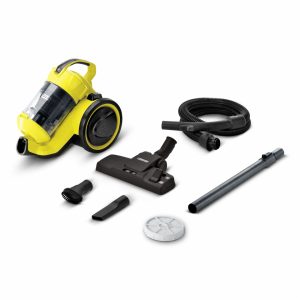
- Type of cleaning: dry
- Power Consumption: 750 W
- Type of dust collector: bagless, cyclone filter
- Dust box capacity: 1.10 L
- The volume of the functional cleaning process: 76 dB
- Overall indicator of a wire: 7.5 m
- Weight: 4.4 kg
- Additional brush brushes included in the basic package: yes (floor / carpet; crevice, for furniture)
- Options provided: the presence of a fine filter, a designated place on the housing for storing additional nozzles
- high suction power
- noise level when cleaning flooring
- intuitive process for using and cleaning the vacuum cleaner
- compact dimensions
- design
- low power consumption
- insufficient wire length
- Excessive electrostatics due to plastic housing
- in the basic configuration there is no nozzle for cleaning cracks from dirt
- lack of function buttons on the handle of the vacuum cleaner
- insufficient dust container capacity
Thomas Multi Cyclone Pro 14
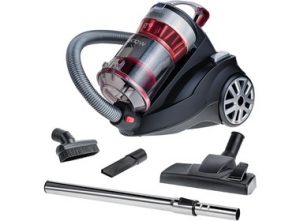
- Variety of possible cleaning: dry
- Power Consumption: 1800 W
- Type of pollution collector: cyclone
- Dust collector flask volume: 2 l
- Noise generated during the cleaning process: 80 dB
- Electric cable length: 6 m
- Weight characteristic: 5.5 kg
- Additional accessories: nozzles (floor / carpet; crevice, 2-in-1 (for upholstered furniture / brush))
- Third-party options: power regulator located on the vacuum cleaner body, fine filter provided by the manufacturer, nine-meter range
- many additional nozzles included in the basic package
- good power level
- compact sizes
- acceptable noise generated when cleaning the floor
- light weight
- inconvenient nozzle designed to clean furniture
- odor arising from direct use
- strong heating of the gadget with prolonged cleaning
- defective fasteners
We bring to your attention the entire lineup vacuum cleaners thomas.
Philips FC8761 PowerPro
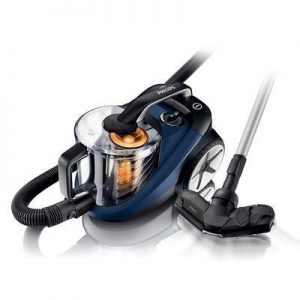
- Cleaning Classification: Dry
- Power Consumption: 2000 W
- Maximum suction power: 360 W
- Type of bagless collection system: cyclone filter
- Dust container dimensions: 2 L
- The volume of the vacuum cleaner: 80 dB
- Power cable length: 8 m
- Weight indicator: 5.5 kg (+ - 100 g)
- Nozzles in the basic delivery: yes (floor / carpet TriActive; crevice; small)
- Functions provided by the manufacturer: buttons on the housing for regulating the suction force, the presence of a HEPA filter, an 11-meter radius of effective operation
- original power
- small overall dimensions
- convenience of cleaning the dust bag
- long cable
- lack of resistance to mechanical damage
- electrostatics accumulated by the plastic used to make the gadget
- limited number of extra brushes included
- no indicator of fullness of the container for collecting pollution
Philips FC9911 PowerPro Ultimate
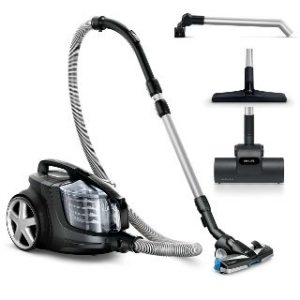
- Types of cleaning: dry
- Maximum power consumption during operation: 2200 W
- Suction power: 400 W
- Dust collector type: cyclone filter
- Dust box capacity: 2.2 L
- Noise Level: 84dB
- Cable length: 7.5m
- Weight: 6.3 kg
- Additional nozzles: yes (floor / carpet TriActive +; crevice; brush / small)
- Built-in options: the presence of a fine filter
- appearance
- high suction power
- convenient dust bag cleaning system
- maneuverability
- HEPA filter
- high noise generated during operation
- dimensions
- lack of functional controls on the handle
Shivaki SVC 1748
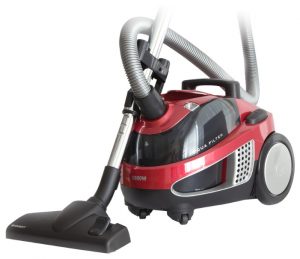
- Types of cleaning: dry
- Maximum power consumption during operation: 1800 W
- Suction Power: 410 W
- Dust collector type: aquafilter
- Dust box capacity: 3.80 L
- Noise Level: 68 dB
- Cable length: 6m
- Weight: 6.3 kg
- Additional nozzles: there is (crevice, for floors and carpets, for upholstered furniture)
- Built-in options: the presence of a fine filter, the ability to adjust the power of the device with a function button located on the case
- high suction power
- build quality
- no need to replace filters
- relative compactness
- the need to clean the dust bag after each cleaning cycle
- high noise generated during operation
- ill-conceived cleaning system and dust collector design itself
- lack of components in stores
Thomas TWIN T1 Aquafilter

- Types of cleaning: dry, wet
- Maximum power consumption during operation: 1600 W
- Suction power: 400 W
- Dust collector type: aquafilter
- Dust box capacity: 4 L
- Noise Level: 70dB
- Cable length: 6m
- Weight: 8.4 kg
- Additional nozzles: there is (floor / carpet, washing nozzle for carpets with an adapter for smooth surfaces, crevice, for upholstered furniture)
- Built-in options: availability of fluid collection options, the presence of a fine filter
- ease of cleaning the dust bag
- high suction power
- acceptable noise level generated by work
- lack of a provided container for storing additional nozzles
- dimensions
- weight, especially with a filled water tank
KRAUSEN AQUA STAR

- Types of cleaning: dry, wet
- Maximum power consumption during operation: 1000 W
- Suction power: 450 W
- Dust collector type: aquafilter
- Dust box capacity: 3.20 L
- Noise Level: 75 dB
- Cable length: 9m
- Weight: 5 kg
- Additional nozzles: there is (for walls and floors; with a hard synthetic pile; with a soft synthetic pile; for collecting liquid; universal; crevice)
- Built-in options: the presence of a fine filter, the ability to connect an electric brush, aromatization function
- high level of air filtration
- lack of replaceable components
- wet cleaning option available
- high noise generated during operation
- insufficient suction power
- the need to clean the dust bag after each cleaning cycle
- lack of automatic cable rewind option
SUPRA VCS-2086

- Types of cleaning: dry
- Maximum power consumption during operation: 1800 W
- Suction Power: 380 W
- Dust collector type: aquafilter
- Dust container capacity: 1.50 L
- Noise Level: 76dB
- Cable length: 5m
- Weight: 5.8 kg
- Additional nozzles: yes (turbo brush)
- Built-in options: the presence of a fine filter, the ability to adjust power using a button located on the body, a four-stage filtration system
- reasonable cost
- normal noise generated during operation
- simplicity of the dust bag cleaning process
- poor build quality
- dimensions
- quickly "clogged" filter
SAMSUNG VC18M21A0
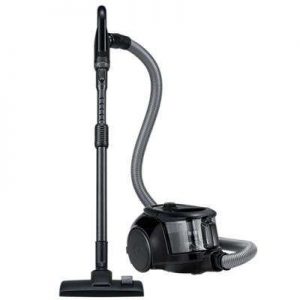
- Types of cleaning: dry
- Maximum power consumption during operation: 1800 W
- Suction Power: 380 W
- Dust collector type: cyclone filter
- Dust container capacity: 1.50 L
- Noise Level: 87dB
- Cable length: 6m
- Weight: 4.6 kg
- Additional nozzles: yes (floor / carpet; nozzle 2-in-1)
- Built-in options: the presence of a fine filter, Anti-Tangle turbine (prevents winding hair, wool and dust on the filter); Easy Grip rotary knob, power regulator located on the vacuum cleaner body
Does your machine cope poorly with animal hair? Take a look at vacuum cleaners for an apartment with animals.
- design
- high suction power with low power consumption
- light weight
- telescopic handle
- leaks in the structure of the housing, in particular, joints
- insufficient cable length
- quick "blockage" of the turbofilter
- frequent overheating
We invite you to familiarize yourself with the rest of the representatives vacuum cleaners samsung.
Thomas AQUA-BOX Compact

- Types of cleaning: dry
- Maximum power consumption during operation: 1700 W
- Suction power: 320 W
- Dust collector type: aquafilter
- Dust container capacity: 1.90 L
- Noise Level: 81 dB
- Cable length: 6m
- Weight: 6.9 kg
- Additional nozzles: there is (floor / carpet; nozzle brush for furniture, crevice 220 mm long)
- Built-in options: the presence of a fine filter, the option of collecting liquid, the ability to adjust power through a function button located on the case
- high suction power
- Convenience of the dust bag cleaning system
- appearance
- the need to clean and dry functional elements after each cleaning cycle
- poor quality body material
- the inability to control the vacuum cleaner with buttons on the handle
In our next article, we understand which vacuum cleaner companies are the best.
Thus, the advantages of vacuum cleaners without a dust bag over traditional counterparts are obvious. Despite a number of negative aspects of their use, the effectiveness of cleaning with modern models of household gadgets for cleaning an apartment or house, in particular, included in the rating of the best, leaves no doubt.


